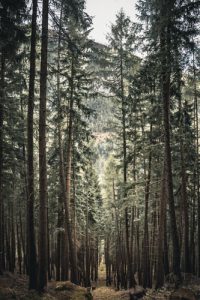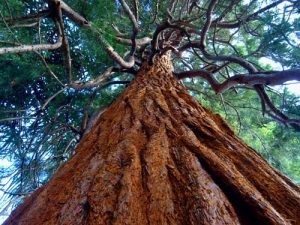 By Debbie Arrington
By Debbie Arrington
Guest Writer
On his seven-acre property in the Sierra foothills, Kevin Marini has seen firsthand the toll of our very dry 2022. Since Jan. 1, rain totals are the lowest on record for many parts of Northern California. Trees and shrubs are showing the impact.
“Needle drop-that’s one thing that happened up here,” observed the longtime Placer County Master Gardener. “There’s a lot of dieback, dead branches (on the lower portion of trunks) and fire ladders. I think the drought during January and February really had an impact on mature trees.”
“Fire ladders”—dead branches along a tree’s trunk—can allow a wildfire to climb up the tree and burn its crown. That will kill the tree as well as allow the wildfire to jump onto other trees—or your roof.
“We’re also seeing the effect of those big December storms,” Marini added.
At the end of a record dry year, December produced record Sierra snowfall. Donner Pass saw 202 inches of snow in that one month; several Sierra communities were buried by 15 feet.
Nicknamed “Snowmaggedon,” those December storms packed a wallop. A combination of the weight of heavy snow plus high winds damaged evergreens. Often, broken branches snagged on other branches and became suspended high above the ground. Limbs snapped but didn’t immediately fall. With rootballs weakened by drought, some big trees toppled over under the weight of snow.
“All the trees got damaged around here, and there are still a lot of limbs dead in trees,” said Marini, who lives between Meadow Vista and Colfax. “A lot of my Ponderosa pines have three, four limbs broken but stuck up in the tree.”
Eventually, wind knocks those dead branches down, adding to the fire danger on the ground. It’s all fuel for wildfire.
“All this dead material and trees are dropping more,” Marini said. “A stiff breeze and another one of those branches with dead pine needles falls down. Everyone in the foothills is really struggling with tree clean-up since December, and there’s still more dead material stuck in the trees. There’s so much to clean up; there are still areas of my property where trees were ripped out of the ground (that need to be removed).”
This brittle dryness intensifies fire danger, Marini added. “I live at the top of a hill; fire is always a concern with a huge slope beneath you (because fire spreads uphill). This year, there’s a lot more fuel. That can make for a really tough fire season ahead.”
Marini, community education specialist for the UC Cooperative Master Gardeners of Placer County, has become a firescaping specialist—using landscaping to help protect your home from wildfire. He’s recorded a podcast on the topic with Green Acres Nursery & Supply (https://www.buzzsprout.com/1610311/10766741-defensible-spaces?t=0) and practices his own advice.
The biggest thing: Create defensible space around your home. In wilderness and high-fire areas, CalFire recommends a 100-foot buffer around structures with grasses mowed and potential fuel minimized. The first 5 to 10 feet should be “ember resistant” – nothing that can burn. Use hardscape or gravel, not plants, next to your home. No trees or shrubs should overhang roofs or come in contact with decks and buildings.
Within 30 feet of structures, landscaping should be “lean and green”—well maintained and healthy plants spaced far apart. Trees and shrubs should be at least 10 feet apart— no touching branches—to help keep flames from jumping from branch to branch. No hedges.
no touching branches—to help keep flames from jumping from branch to branch. No hedges.
This summer, the priority is clean up, Marini said. All those fallen pine needles can create a thick thatch; embers can actually burn and spread fire below the thatch, then suddenly erupt into flame. Three inches of pine needles is OK, says CalFire. Otherwise, get out the rake. Remove fallen leaves, needles, twigs, bark, cones and small branches. Also clean up and remove fallen branches, downed trees and other large flammable debris.
Cut back trees. Remove any limbs that extend near roofs and structures. Eliminate any dead branches or fire ladders.
Take care of your trees and keep them healthy. Deep water, if possible (especially trees near structures). Mulch, mulch, mulch; use green wood chips that still contain some moisture.
Watch for signs of drought stress such as dieback or a tree that appears to be leaning. “When trees totally come out of the ground, you can see how the rootball was compromised,” Marini said. “In drought, the rootball shrinks and the tree becomes unstable.” Trees along roads or other pavement tend to be at greater risk because their roots are already stressed by constant compaction.
Defensible space is a community effort: Your home may still be at risk if your neighbor’s property is a tinderbox. Work with your neighbors to tackle trouble spots. This season, Marini noted a growing awareness of fire danger and defensible space. “On the positive side, I’ve seen more action since December than I ever have before. People are taking action to reduce fuel.”
For more information on defensible space, see these CalFire recommendations: https://www.fire.ca.gov/dspace/.
Debbie Arrington is a longtime home and garden reporter and co-author of the blog Sacramento Digs Gardening: https://sacdigsgardening.blogspot.com/
Learn More:
Creating a Landscape that Fights Fire AND Saves Water

